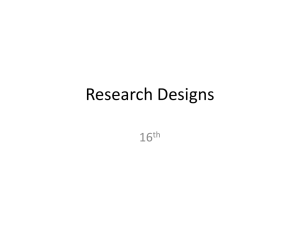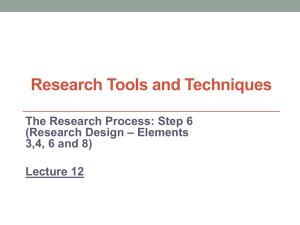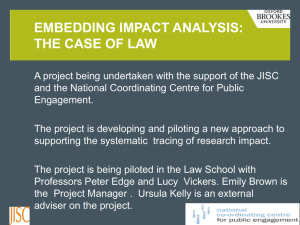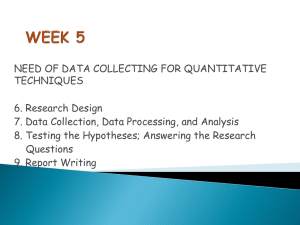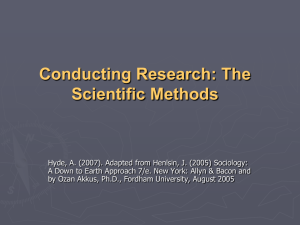the research process: elements of research designs
advertisement
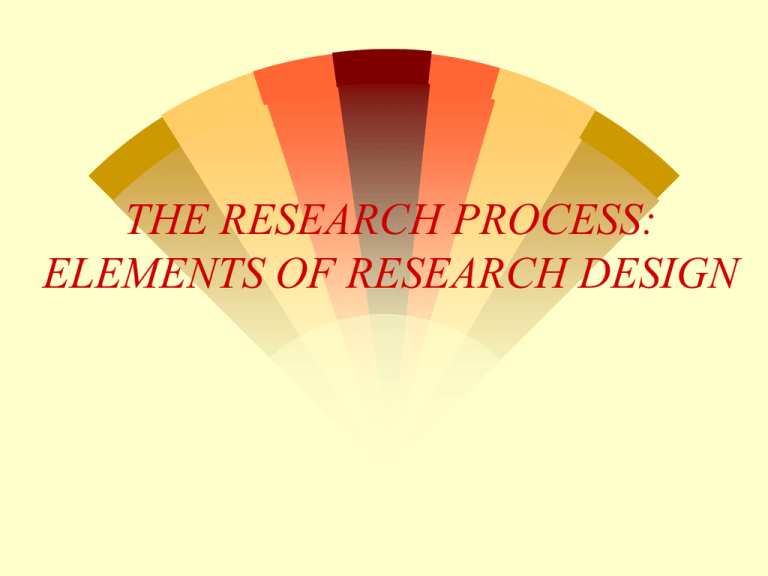
THE RESEARCH PROCESS: ELEMENTS OF RESEARCH DESIGN The Research Process The Research Design • Many definitions of research design: • Constitutes the blueprint for collection, measurement, and analysis of data • Aids the researcher in the allocation of limited resources by posing crucial choices in methodology • The plan and structure of investigation so conceived as to obtain answers to research questions • Express both the structure of the research problem and the plan of investigation used to obtain empirical evidence on those relationships The Research Design (Cont’d) • The essentials of research design: • An activity- and time-based plan • A plan always based in the research question • A guide for selecting sources and type of information • A framework for specifying the relationships among the study’s variables • A procedural outline for every research activity The Research Design (Cont’d) • Issues relating to decisions regarding: • • • • • • The purpose for the study Study setting Type of investigation Extent of researcher interference Time horizon Unit of analysis The Research Design (Cont’d) • Issues relating to decisions regarding (Cont’d): • • • • Sampling design Data collection methods Measurement Data analysis The Research Design (Cont’d) DETAILS OF STUDY Purpose of the study PROBLEM STATEMENT Exploration Description Hypothesis testing Type of investigation Establishing: 1. Causal relationship 2. Correlations 3. Group differences, ranks, etc Extent of researcher interference Minimal: studying events as they normally occur Manipulation and/or control and/or simulation MEASUREMENT Study Setting Contrived Non contrived Measurement and measures Operational definition Items (measure) Scaling Categorizing Coding DATA ANALYSIS 1. Feel for data 2. Goodness of data Unit of analysis (population to be studied) Individuals Dyads Groups Organizations Etc Sampling design Time horizon Probability/ nonprobability Cross sectional Sample size Longitudinal Data collection method Observation Interview Questionnaire Physical measurement Unobstrusive 3. Hypothesis testing Purpose of the study • Exploratory: • Undertaken when not much is known about the situation at hand, or no information is available on how similar problems or research issues have been solved in the past Purpose of the study (Cont’d) • Descriptive: • Undertaken in order to ascertain and be able to describe the characteristics of the variable of interest in a situation Purpose of the study (Cont’d) • Hypotheses testing: • Undertaken to explain the variance in the independent variable or to predict organizational outcomes Type of Investigation • Causal • The study in which the researcher wants to delineate the cause of one or more variables • Correlation • When the researcher is interested in delineating the important variables associated with the problems Extent of Researcher Interference • Minimal • Moderate • Excessive Study Setting • Contrived • Artificial settings • Noncontrived • Natural environment Unit of analysis • Refers to the level of aggregation if the data collected during the subsequent data analysis stage • Individual, dyads, groups, etc Time Horizon • Cross sectional • Data are gathered just once • Longitudinal • Data are gathered at more than one point in time
